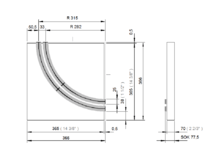T-Trak
T-TRAK is a modular standard in the hobby of model railroading, which uses modules 2 3⁄4 inches (70 mm) high, which rest on a table, such as a banquet table. A layout typically consists of four corner modules, each of which has two tracks making 90° curves.[1] Straight modules, measuring 1 or 2 feet (0.30 or 0.61 m) wide [2][3] are fitted between the corner modules, so that the layout makes a closed loop.


T-TRAK is based on a particular track product, namely Kato Unitrack, at least for the interfaces to the adjacent module.[4] [5] Kato Unitrack has joiners which are quick to connect and disconnect to the adjacent track. The tracks are fixed to the base, and the joiners join the modules as well as the track.
History of T-TRAK
T-TRAK was developed in Japan, but was popularized in the United States by Lee Monaco-FitzGerald.[6] It has become popular, because it can be constructed in a small space, and layouts can be assembled on a table such as a banquet table or even a dining room table. Clubs such as Cub Scouts have made layouts where each member makes a module and they are put together at meetings, thus allowing each member to contribute while the operation is the result of the collaboration of all members.[7] Modules can also be set up at senior centers or church halls for temporary demonstrations. There is a very active Yahoo discussion group.[8]
T-TRAK standards


T-TRAK was originally designed for N-Scale, but there are also standards for HO scale, as well as other scales. [9] There is a large group of HO T-TRAK modelers in Australia. The center-to-center spacing of two tracks in N-scale can be either 25 millimetres (0.98 in) or 33 millimetres (1.3 in). [10] Most modelers use the 33 mm spacing to accommodate longer cars and locomotives and to interface with Kato standard track pieces such as concrete track and double crossover switches.
Single module size for N-Scale is 12 1⁄8 inches (310 mm) wide by 8 1⁄4 inches (210 mm) deep. Depth of a straight module can be up to the size of a corner module (usually 14 3⁄8 inches (370 mm)). Depth is often 12 inches (300 mm), 13 inches (330 mm), or 14 inches (360 mm) inches, rather than the full size of a corner module. This allows more space for scenery, and does not crowd the center of the table. Corner modules are 14 3⁄8 inches (370 mm) square.[11]
In HO scale, track centers are 60 millimetres (2.4 in).[9] Single module size for HO scale is 19 1⁄4 inches (490 mm) wide by 28 inches (710 mm) or 20 inches (510 mm) deep. Corner modules are 28 inches (710 mm) square.[9]
External links
| Wikimedia Commons has media related to T-Trak. |